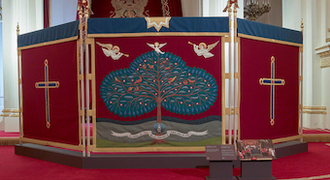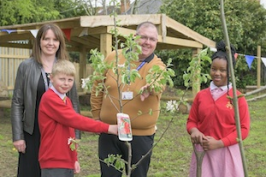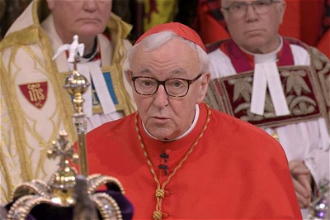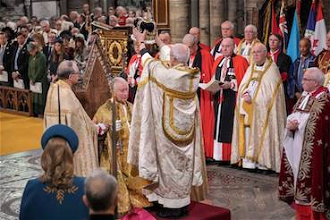Coronation display at Summer Opening of Buckingham Palace

The Anointing Screen. Royal Collection Trust © .. His Majesty King Charles III 2023
A stunning Coronation display is at the heart of this year's summer opening at Buckingham Palace. Situated in the Ballroom digital images of the Garter banners at St.George's Chapel Windsor hang from the ceiling .The chivalric Order of the Garter, dedicated to the Blessed Virgin Mary and St.George, was inaugurated by Edward III in 1348 and the Order's Insignia worn at the Coronation is displayed alongside the Coronation robes and accoutrements worn by Their Majesties
Alongside the Throne Chairs is the memorable seven foot Anointing Screen Renowned Shropshire based Orthodox iconographer Aidan Hart was invited by King Charles to design the screen.
Hart has taught courses on icons for many years for the Prince's Art Foundation. The design selected by the King was inspired by the stained-glass Sanctuary Window in the Chapel Royal at St James's Palace.
Facing the High Altar during the rite of Anointing the screen protected him from public view during the most sacred moments. At the top is the sun, representing God. Angels blowing trumpets symbolise uniting heaven and earth. Beneath them is a tree, symbolic of the Tree of Life, on the central panel fifty six leaves represent the countries of the Commonwealth. Modern technology as well as skilled embroidery by members of the Royal School of Needlework at Hampton Court were incorporated. The tree's outline was created by Digitek using sustainable thread, Madeira Sensa, made from 100% lyocell fibres. The leaves were hand embroidered along with birds, including the dove of the Holy Spirit. Beneath the tree trunk is the King's cypher indicating he is servant of the people. At the bottom of the screen a scroll is inscribed with the words of medieval mystic Julian of Norwich, "All shall be well and all manner of things shall be well." The lettering is by Welsh calligrapher David Jones as is that used for the names of the Commonwealth countries. The materials used to create the Anointing Screen were sourced sustainably from across the UK and other Commonwealth nations. The cloth is made of wool from Australia and New Zealand, woven and finished in UK mills.
On each of the side panels gold, blue and red crosses are embroidered on maroon fabric, inspired by the colours and patterning of the ancient Cosmati Pavement at Westminster Abbey upon which the Anointing took place.
A wooden poled framework, designed and created by Nick Gutfreund of the Worshipful Company of Carpenters supports the screen. The poles derive from a windblown oak tree from the Windsor Estate, planted by The Duke of Northumberland in 1765. They were limed and waxed, combining traditional craft skills with a contemporary finish and surmounted by two bronze eagles gilded in gold leaf, cast by Tim Royall. Eagles symbolise God's strength, protection and transcendence.
Another notable exhibit is The Stole Royal, resembling a priestly stole. Designed by the College of Arms it incorporates the nations emblems of rose, thistle, leek and shamrock. A series of embroidered roundels applied to a cloth of gold feature the dove representing the Holy Spirit, a Tudor crown, the crossed keys of St. Peter, to whom Westminster Abbey is dedicated and a pattern inspired by the Cosmati pavement. The four Evangelists are depicted by their motifs of an Angel, winged Lion, winged Ox and Eagle bearing their Gospel.
On the nape of the neck is an icon of St. Lawrence, patron of the Girdlers Livery Company, established in 1327, who gifted the stole. During the service it was presented to the Sovereign by the Prince of Wales before Anointing.
The tour includes the magnificent State Apartments. The impressive Picture Gallery has an array of Old Masters including a fine selection of Van Dycks. A radiant portrait of Queen Henrietta Maria, the Catholic wife of King Charles I, depicts her attired in a shimmering silver dress bedecked with lace. Beside her is the crown. The Monarch knighted the artist who married one of the Queen's Ladies in Waiting.
On the right wall is a resplendent Italian seventeenth century wall hanging in silk embroidery on linen of The Annunciation, from the Barberini workshop in Rome. One of a set of five acquired by George IV, the others now hang at Hampton Court Palace.
Noted for his love of horticulture, His Majesty has already made changes to the Palace gardens under a new Head Gardener, the first woman to hold the position. Vegetation has been cut back to give clearer views of the lake and British wild and garden flowers have been planted. Frothy white hydrangeas enhance the public route. A handout for youngsters to note wildlife and botanical species along the trail is another environmental innovation.
Delicious teas are available on the terrace. The beehive cake with honey cream is reputedly the King's favourite!
Until 24th September Thursday-Monday only
Admission charges. See: www.rct.uk


















